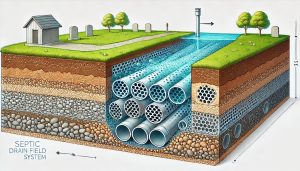In New Hampshire, understanding NH septic tank size requirements is essential for homeowners and property developers. Properly sizing a septic tank ensures the wastewater system functions efficiently and complies with local regulations. This article will explore the guidelines and factors that influence septic tank size, helping you make informed decisions about your system’s design and installation.
Article: New Hampshire Septic License
Table of Content
- What Is a Septic Tank?
- NH Septic Tank Size Requirements
- Factors Influencing Septic Tank Size
- How to Determine the Correct Septic Tank Size
- Septifix
- Septic Permit Links by State
What Is a Septic Tank?
A septic tank is an underground system designed to treat and store household wastewater. It separates solids from liquids, breaking down organic matter through natural processes. Septic systems, also called wastewater treatment systems or sewage systems in some regions, are vital for properties not connected to municipal sewage lines.
NH Septic Tank Size Requirements
General Septic Tank Size Guidelines in NH
In New Hampshire, septic tank size requirements are generally based on the size of the home and the number of residents. For residential properties, the standard septic tank size is typically 1,000 gallons, but this can vary depending on the property’s unique characteristics. Larger homes or commercial properties may need larger tanks.
Regulations for Tank Size Based on Household Size
The size of the septic tank depends on the number of bedrooms in a home. For example:
- A 3-bedroom home typically requires a 1,000-gallon tank.
- A 4-bedroom home may need a 1,250-gallon tank.
This guideline helps ensure that the septic system can effectively handle the volume of wastewater generated by the household.
State and Local Regulations
Both state and local regulations affect septic tank requirements. The New Hampshire Department of Environmental Services (NH DES) provides general guidelines, but local municipalities might have stricter standards. Always consult with your local health department to confirm the specific requirements for your area.
Factors Influencing Septic Tank Size
Household Size and Wastewater Flow
The more people living in a home, the larger the septic tank should be to accommodate the higher wastewater flow. Larger families or homes with frequent water usage (e.g., multiple bathrooms, laundry rooms) may need a larger tank to prevent system failure.
Property Size and Site Conditions
Septic system design also depends on property size and soil conditions. A larger lot with well-draining soil might offer more flexibility in tank sizing, whereas smaller lots or areas with poor soil drainage may require larger or more complex systems to manage wastewater.
Additional Factors
Special circumstances such as properties with home businesses or high water usage might require larger septic tanks or additional systems to handle the extra demand.
Article: What Are the New Regulations for Septic Tanks?
How to Determine the Correct Septic Tank Size
To determine the appropriate septic tank size, consider the following:
- Household size: More people result in higher water usage, necessitating a larger tank.
- Property conditions: Lot size and soil type can impact the system’s design and tank capacity.
- Local regulations: Verify requirements with local health departments or building authorities.
While guidelines can help, it’s best to consult with a professional to ensure the septic tank is correctly sized for your property.
Septic Tank Installation and Permits in NH
Steps for Installation
Installing a septic tank in New Hampshire involves several stages:
- Site evaluation: Soil testing and site assessment are required to ensure the tank will function properly.
- System design: A licensed contractor will design the system based on household size and soil conditions.
- Installation: After obtaining the necessary permits, the tank is installed and connected to the drain field.
How to Obtain a Septic Permit in NH
Before installation, you must obtain a septic permit from your local health department. This process involves submitting plans for the septic system, which will be reviewed to ensure compliance with state and local standards. Approval is required before any work can begin.
Maintenance Tips for Your Septic System
Regular Pumping and Inspection
To ensure your septic system remains functional, regular maintenance is essential. Most septic tanks should be pumped every 3-5 years, depending on usage. Inspections should also be performed to check for signs of damage or potential issues.
Signs of a Full or Failing Tank
Look for the following warning signs of a failing septic system:
- Slow-draining sinks or toilets
- Gurgling sounds from the plumbing
- Foul odors around the drain field
If you notice any of these, contact a professional for an inspection.
Contact Information and Resources
- Septic System Service Providers: Reach out to local experts for septic tank installation and maintenance in New Hampshire.
- NH DES: Visit the New Hampshire Department of Environmental Services website for comprehensive guidelines on septic system requirements.
- Local Health Departments: Contact your town or city health department for specific septic system regulations and permits in your area.
Conclusion
Understanding and following NH septic tank size requirements is essential for ensuring that your septic system functions properly and meets legal standards. By considering factors like household size, property conditions, and local regulations, you can choose the right septic tank size for your home. For professional guidance and installation, contact a local septic expert today.
Septifix









